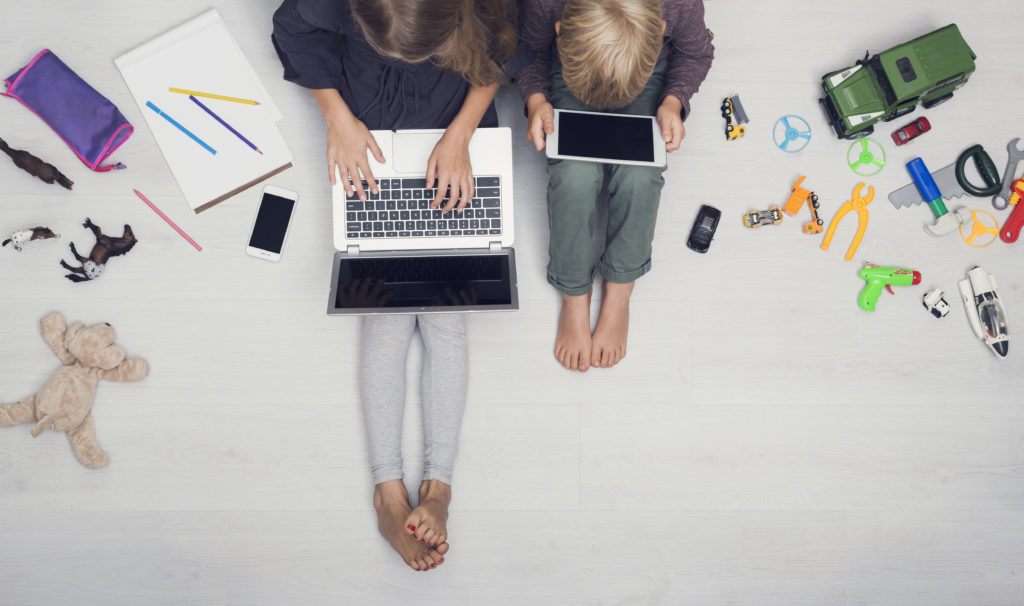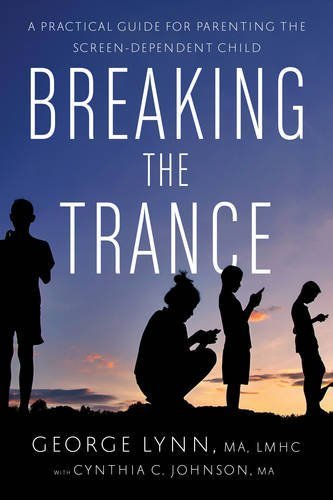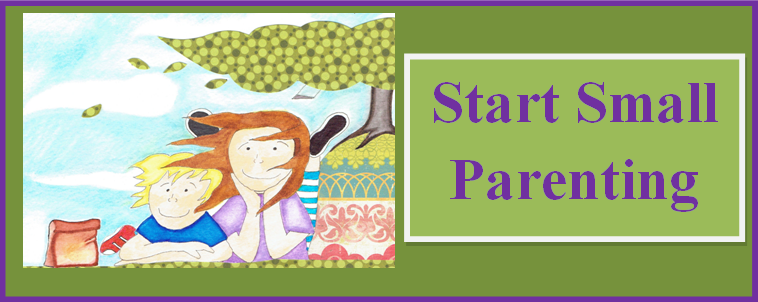
Screen media use (accessing digital content on tablets, cell phones, etc.) is here to stay. Everyone I know, and the articles I read, state this obvious fact.
At the risk of alienating many families, I want to call out screen dependency as the coma to which we have willingly, yet unconsciously, succumbed. How strongly can I state my dismay, grief, and alarm at the veil we have allowed to place over this experience?
Many parents I know vacillate between two justifications for their child’s screen dependency. One is acceptance: “Screens are here to stay and I can’t possibly fight an uphill battle.” Another is denial of any harmful effects of screen use: “My child’s generation has adapted and can multi-multi task. He’s actually doing fine.”
Either of these puts the parent in a victim role. At the same time, parents justify their own increased screen use and deny screen dependence.
A Trance
In his book, “Breaking the Trance,” psychotherapist George Lynn proposes that parents are in a trance state regarding screen use. He defines the trance state as a psychological concept describing our patterned response to certain stimuli. This is informed by our invisible bubble of beliefs and expectations which allow our reactions to be automatic and predictable.
 Lynn writes:
Lynn writes:
“The proliferation of screen media, as well as the tendency to design it to create compulsive use, has entranced the population gradually. Everyone is especially vulnerable to this public health challenge because it has crept up slowly, and when change happens slowly, people tend to not be very mindful of it.”
With my personal realization of this comes confusion and guilt over my son’s (and my own) media use. Lynn urges parents to forgive themselves for not knowing what to do regarding their children’s screen use and that we are all making the best decisions we can based on the information we have.
Severity of Screen Dependency
The American Academy of Pediatrics recommends less than 1 hour a day of recreational screen media use for developing minds. Research suggests that no measurable neurologic changes occur at this level. Beyond that, there are destructive changes in brain function involving mood issues, mental processing, sleep disruption, organization, emotional balance, and social interactions.
Severity of screen dependency starts in the Mild range at 2 hours a day. Severe use is up to 14 hours a day.
Free Time
Unstructured, unregulated, disorderly “free time” allows children to explore their inner and outer worlds. This is the beginning of creativity where they imagine, invent, and engage with themselves and life around them. The study of child development clearly teaches that this process starts with boredom.
Within solitude and quiet of the mind, curiosity can live. Free time opens possibilities for children to explore their passions, listen to their heart, solve problems, make meaning of life, and develop self-direction. Without periods of unstructured time and deciding for themselves how to use it, children lack practice in managing free time.
Optimum Growth
I not only want my son to get by in life but to reach toward optimum growth as a whole person. This is an internal process from the inside out. The experience of media, even educational media or apps designed to encourage imagination, occur outside the child. I want him to be in situations where he has to use his mind to overcome real obstacles – not virtual ones.
Many children are expert at doing enough in the real world to stay off the parental radar of concern. My son is in the Mild range of screen use and still able to manage schoolwork and other activities like piano, theater, and design projects, but often only at our urging if media is available instead.
Lynn points out that getting good grades should not be used as a marker for more screen media use. Although grade point average plays a role in screen assessment by many parents, it’s important to observe how the child engages in the more messy aspects of life including relationships, decision-making, household contributions, pursuing real-world interests, and most importantly, free time.
Setting Limits
Pre-Smartphone, my child had more free time. With access to pervasive and immediate entertainment and social interaction opportunities, he rarely has free time unless my husband and I hard-line the phone limits. He loves to be on his Smartphone, talks often about what he sees on it, anticipates when he can next use it if not on it, and gets restless or irritable when the phone limits are suggested. This becomes an exhausting interaction of control enforcement, one that many parents I know have conceded.
We have encouraged our son to create the limits with us. We have removed certain privileges if he lies to us about his use or ignores the rules. The best result for re-engaging our son with his creativity, though, has been the occasional but complete removal of screens. My son, awake from his trance, can be found in the garage using power tools or outside hiking the dog. He can hold a train of thought in conversation. His eyes don’t dart furtively around the room when speaking. I don’t need the Academy to tell me that too many hours of screen time creates changed, even harmful, behavior.
Each period of screen time removal has ended in a slow, mostly benign, reintroduction. A movie during a sleep-over seems harmless and fun. My son texts me sentimental thoughts, emojis, and comments on his whereabouts and I want more of that. He uses FaceTime for social interactions, which has the advantage over texting of real conversation in real time. He watches YouTube videos of backflips and snowboard tricks, and as a visual learner this actually helps improve his real world skills.
These benefits occur before the more pervasive trance takes hold once again. Before too long, the phone is ever-present – YouTube videos are used to unwind, memes replace books, texting is more important than real time conversation, and my son’s personality is affected.
A Plan
My husband recently snapped. The amount of energy that screen control takes – whether discussing, anticipating, or instilling limits – drains our resources and negatively influences family connections. We could see two undesirable options – either unlimited screen access with a walking Zombie for a son, or no screen time at all.
Then I read George Lynn’s book. He has another plan. Using clinical examples and specific guidelines, Lynn equips parents with tools for measuring the presence of an issue with screen media use and provides a two phase program to get screen-dependency under control. He reminds us that we are the parents and by necessity, we are in charge.
Our children need us to step up, take charge, and make a plan that works for our families.

